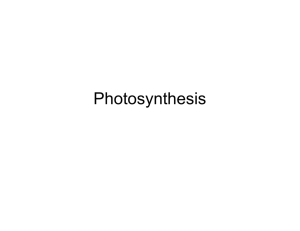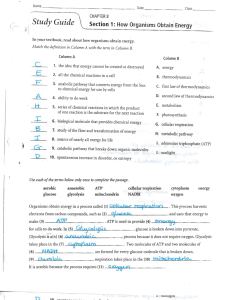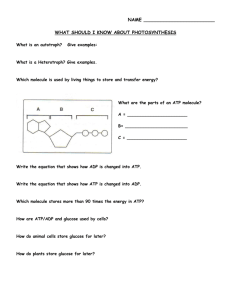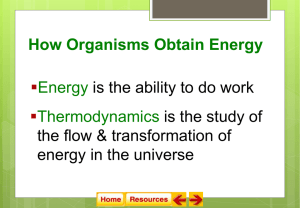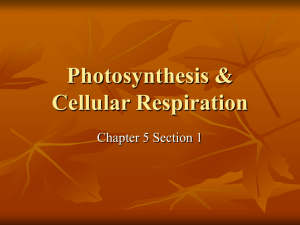Photosynthesis and Cellular Respiration
advertisement
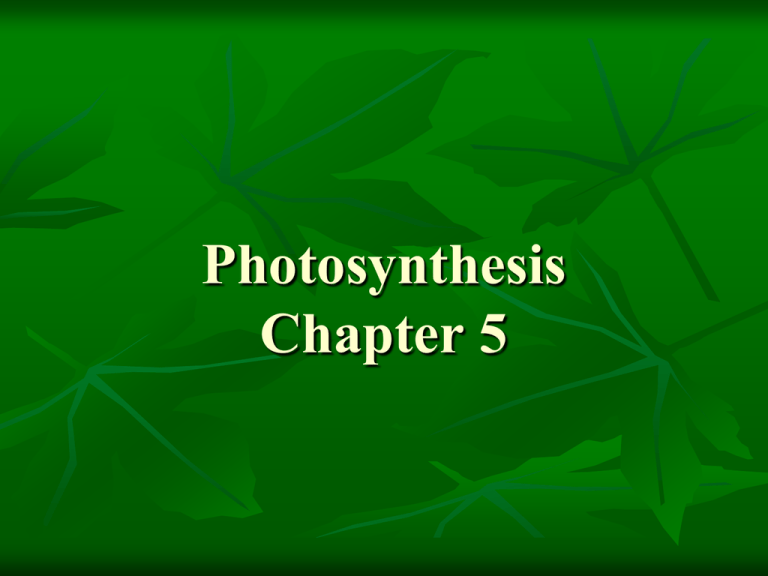
Photosynthesis Chapter 5 Outline I. Photosynthesis A. Introduction B. Reactions Photosynthesis Method of converting sun energy into chemical energy usable by cells Autotrophs: self feeders, organisms capable of making their own food – – Photoautotrophs: use sun energy e.g. plants photosynthesis-makes organic compounds (glucose) from light Chemoautotrophs: use chemical energy e.g. bacteria that use sulfide or methane chemosynthesis-makes organic compounds from chemical energy contained in sulfide or methane Overall Reaction of Photosynthesis 6CO2 + 12 H2O + light energy → C6H12O6 + 6O2+ 6H2O Carbohydrate made is glucose Water appears on both sides because 12 H2O molecules are required and 6 new H2O molecules are made Water is split as a source of electrons from hydrogen atoms releasing O2 as a byproduct Electrons increase potential energy when moved from water to sugar therefore energy is required Photosynthesis Photosynthesis takes place in specialized structures inside plant cells called chloroplasts (Light absorbing pigment molecules) – Chlorophyll a – Chlorophyll b – Accessory pigments (auxiliary pigments) Carotenoids (are usually red, orange, or yellow pigments) Photosynthesis - Chlorophyll’s When you shine white light on chlorophyll, its molecules will absorb certain colors of light. The light that isn’t absorbed is reflected, which is what our eyes see. Green is what we see and all the rest red, orange, yellow & blue are absorbed. Light-dependent Reactions Overview: On the thylakoid membrane the light energy is absorbed by chlorophyll molecules-this light energy excites electrons and boosts them to higher energy levels. They are trapped by electron acceptor molecules that are poised at the start of a neighboring transport system. The electrons “fall” to a lower energy state, releasing energy that is harnessed to make ATP & NADPH. Light-dependent Reactions What happens to the water? Photosystem II’s stolen electron is replenished by photolysis, or the splitting of H2O to form H+and O2 (note: the H+ is kept inside the thylakoid membrane). The O2 resulting is the source of all oxygen in our atmosphere. Light-dependent Reactions What happens to the water? Light-dependent Reactions Photosystem: light capturing unit, contains chlorophyll, the light capturing pigment Electron transport system: sequence of electron carrier molecules that shuttle electrons, energy released to make ATP Electrons in chlorophyll must be replaced so that cycle may continue-these electrons come from water molecules, Oxygen is liberated from the light reactions Light reactions yield ATP and NADPH used to fuel the reactions of the Calvin cycle (light independent or dark reactions) Stroma PHOTOSYNTHESIS (All happens inside chloroplast) Calvin Cycle (light independent or “dark” reactions) ATP and NADPH generated in light reactions used to fuel the reactions which take CO2 and break it apart, then reassemble the carbons into glucose. Called carbon fixation: taking carbon from an inorganic molecule (atmospheric CO2) and making an organic molecule out of it (glucose) Simplified version of how carbon and energy enter the food chain
